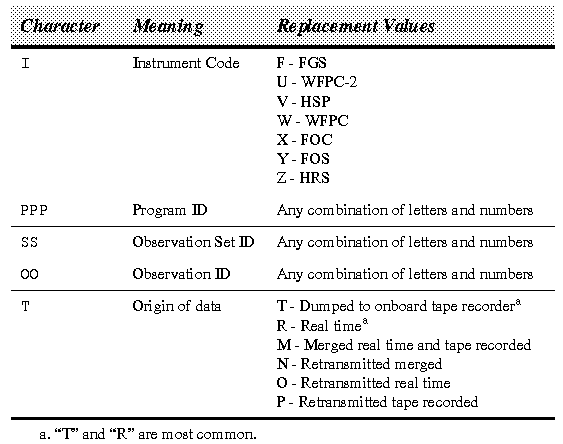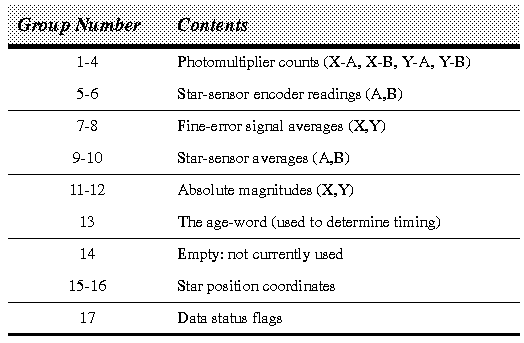





image.hhh image.hhd data.abh data.abd fosimg.d0h fosimg.d0dThe following, however, are not valid STSDAS image names:
image.hhh image.ddd # extensions are different data.abh data.dat # extensions totally different fosimg.d0h FOSimg.d0d # root names differentDon't forget that with IRAF's virtual file name conventions, file names are case sensitive; this is what invalidates the last example.
Actual data from the RSDP pipeline follows a more restricted set of rules:


Other conventions also apply, but these cover most standard science data. (See Interface Control Document 19: PODPS to STSDAS, Section 6, for details.)
A typical output file from the calibration pipeline might, for example, be called w09h10a0t.d0h and w09h10a0t.d0d. This file can be identified as a WF/PC data file, with program ID 09H, observation set ID 10, observation ID A0, originating from the on-board tape recorder. It is uncalibrated science data.
Obviously, HST data files names are going to be awkward to type and will take some practice to identify. The task iminfo in the STSDAS tools package will decode a file name and print out the most relevant information from the file header (tailored for each instrument).
Instrument-Specific Data Structures
The data from each instrument are stored in a number of separate files--there are files for raw data, calibrated data, data quality, standard header packets, unique data logs, and trailer files.*1 These files are named according to the conventions described on page 48; the raw and calibrated data file structures are described on page 40. The structure of data quality files is similar to the science data, except that the data values have a rather restricted range: zeroes and ones for some instruments, or specific flag values indicating the types of pathologies that might affect a given pixel in the associated data files.
The standard header packets (SHP) and unique data logs (UDL) contain information related to telemetry, instrument command, spacecraft orbit and pointing, and other instrument monitoring measurements. Most of the useful information in these files appears in the file header, in FITS style KEYWORD = VALUE notation. Binary data can only be interpreted as bit-streams; one needs to know the start and stop bits for a particular piece of information. Users ordinarily do not need to extract information from binary data in the SHP or UDL files because a more readable copy of the data exists in the header. Trailer files are a log of processing steps and any anomalies noted during routine calibration. These files are in plain text format.
The Wide Field/Planetary Camera has eight CCD detectors--four of which are used in PC mode, four in WFC mode--that create four images. These four images are stored as four groups in an STSDAS data file. A particular observation may not use all four CCDs, so fewer groups may appear in a WF/PC data file. The group parameter block for a WF/PC science data file has 37 group parameters and includes information about the image (minimum and maximum values, coordinate system), the data quality (numbers of defective pixels), and photometry.
Like WF/PC, the WF/PC-2 has four CCD detectors that create four images, each of which are stored as a group in an STSDAS image. A given observation may not use all four detectors so there may be fewer than four groups in a WF/PC image. The group parameter block has 49 parameters that are used for information about the image (minimum and maximum values, coordinate system, etc.), the data quality (numbers of defective pixels), image statistics, and photometry.
Faint-Object Camera datasets have only one group. The group parameter block has 20 parameters that are used for image-related information such as minimum and maximum values and the coordinate system.
High Speed Photometer files also have only one group. However, HSP data sets can be very large (such as when an observation is taken using the highest possible time resolution over half an orbit) and may be broken up into more manageable parts. The group parameter block has 14 parameters, including the usual image descriptors.
Faint Object Spectrograph and High Resolution Spectrograph data files have many groups--thousands in their time-resolved modes. The HRS group parameter block has 27 parameters, and the FOS has 19 group parameters.
Each astrometry science data set consists of three sets of files (header and binary data)--one for each of the three Fine Guidance Sensors. These files are named much like other science data, with a root file name that follows the same guidelines described in the previous section (and defined in Table 3.2). The file name extensions are of the form .AnH and .AnD, where n is the digit 1, 2, or 3 and corresponds to the FGS number. Thus, a typical astrometry data set might consist of files like the following:
Groups in Astrometry Files
It should be apparent that the groups in an FGS data file do not represent the same type of data, and there will not necessarily be the same number of valid data points in each group (by definition each group has the same number of values, but each group can be filled out to the total group length with fill values). The AGEWORD group is used to properly assign the correct time of observation to each data value (the STSDAS task puttime, in the stlocal.testfgs package, computes observation times); this is necessary because various quantities in the FGS data file are sampled at different rates.
The headers of the FGS data files contain lots of other information about the observation, and users should consult Interface Control Document 46--AEDP to PODPS for more detailed information.
Generated with WebMaker
 Note that groups are used differently for each instrument. WF/PC uses a group for each detector, FOC and HSP use only a single group for an observation, and FOS and GHRS use dozens (or hundreds) of groups corresponding to each instance of data being read out.
Note that groups are used differently for each instrument. WF/PC uses a group for each detector, FOC and HSP use only a single group for an observation, and FOS and GHRS use dozens (or hundreds) of groups corresponding to each instance of data being read out.
Data from the Fine Guidance Sensors does not get handled in the same way as data from the other science instruments. Because the FGS is considered part of the engineering system on HST, the data from FGS comes down as part of the engineering data stream, not part of the science data stream. The Astrometry and Engineering Data Processing System (AEDP) reformats the FGS data for scientific analysis. Astrometry Data
Astrometry data from the Fine Guidance Sensors is also available in STSDAS GEIS format, but the structure of this data is more complicated than that of the science instruments. Also, astrometry data are not formatted or processed in the routine data processing pipeline, but rather are extracted from the telescope engineering data stream by a system called AEDP (Astrometry and Engineering Data Processing).
f055030em.a1h f055030em.a1d
f055030em.a2h f055030em.a2d
f055030em.a3h f055030em.a3d
Each file contains a total of 17 groups, or subsets, these groups are described in Table 3.4.


